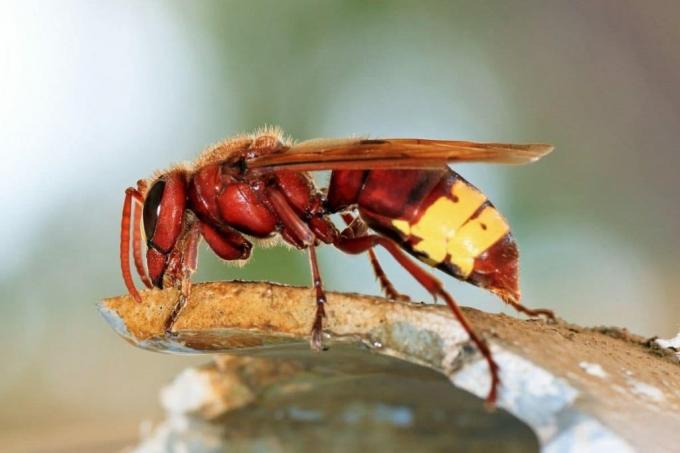
table of contents
- Oriental wall wasp profile
- habitat
- Nests
- Lining
- Assistance
- frequently asked Questions
The oriental mortar wasp is a useful insect that poses no threat to humans. You can find out here how to recognize the nest of such a wasp and what the animals' way of life is like.
In a nutshell
- also known as the oriental wall wasp
- 13 to 21 millimeters in size
- lives solitary (living individually and not in packs, editor's note)
- Nests are built in sheltered places
- Stitches are only used in extreme emergency situations, are hardly painful and not dangerous
Oriental wall wasp profile
The earliest mention of the oriental wall wasp in Europe can be traced back to 1979. It is assumed that the insects were introduced from their original habitat. However, it is unclear whether this was accidental or deliberate. The first sighting took place in Austria.

The following characteristics can help with identification:
Length: Females 13 to 17 millimeters, males 17 to 21 millimeters
Colour: black with yellow to red-brown stripes
Anatomy: noticeable distance between anterior and posterior body segments with a thin connection
Appear: between May and September
habitat
The oriental mortar wasps originally come from the Asian region. She performs in India and Nepal, among others. However, it has also been spreading in Europe for more than 40 years.
For the nest and the breeding caves, the animals choose areas that are protected from rain. They are therefore mainly found in settlement areas.
Note: This species of wasp often lives in apartments. Most of the time, however, people do not notice it. As soon as windows are closed, the animal can make itself felt at the window.
Nests
as Nests and breeding caves the oriental wall wasp builds so-called clay tubs. These are small tubes with an opening at one end. They can appear individually or in groups and serve the wasps as shelter, protection and where they lay eggs.
They are built from different materials. These are:
- Earth
- Clay
- sand
- saliva

Note: The nests are about two to three inches long. After completion and drying out, they are very hard.
Places for nests
The oriental mortar wasp builds the clay barrels in protected places. These include:
- Books
- Gutters
- dark niches
- Window frames
- Clothing and other textiles
- Awnings
- shelves
- cabinets
- Dandruff
Lining
What makes the Oriental Mortar Wasp so useful is its food. It feeds itself and its offspring on, among other things:
- Larvae
- nectar
- Pollen
- be crazy

So they fertilize plants and at the same time keep the populations of other insects in balance.
Wasps collect spiders for their offspring, which they sting beforehand and then bring into the brood cavity. They create a supply so that the young wasps can feed on the spiders first.
Assistance
In very dry phases you can help the wasps by offering building materials for them. All you need is a saucer or a bowl of damp earth, sand or clay. Flowering plants that provide pollen and nectar are also helpful.
It is equally useful to have a Insect hotel to offer with gaps. Here wasps can build nests out of clay and stay away from the house or apartment. Corresponding models can be found online and in brick-and-mortar stores, and they can too self made will.

frequently asked Questions
Yes, the animals can do that. However, the stings are usually not dangerous to humans. In addition, the solitary insects only sting in an extreme emergency, when they feel threatened. However, they do not defend their nests.
No, as the wasps feed on both vegetable and animal sources. They just represent a further supervisory authority. They are also not pests in the garden because they do not gnaw on plants. They don't even bother people while they are eating.
If these are present in disruptive areas and no longer inhabited, the clay tunnels can be removed. In the rarest of cases, however, this is absolutely necessary.



